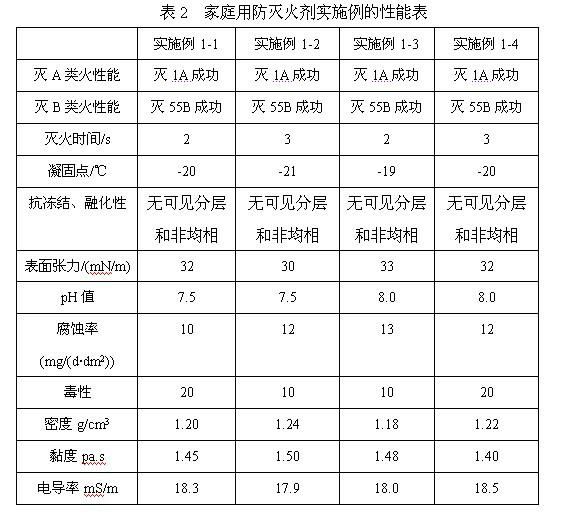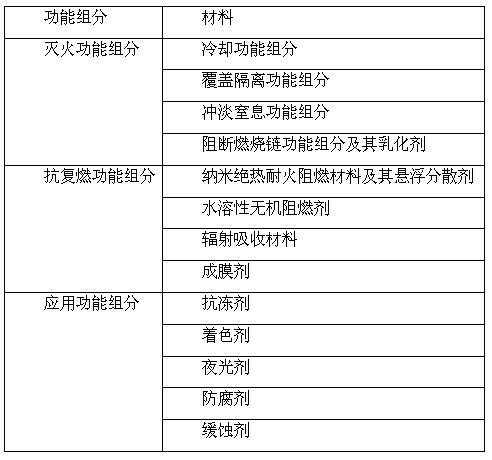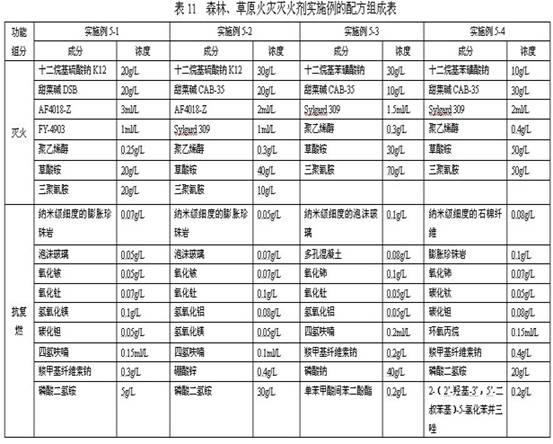Built-up synergetic class-A/B water extinguishing agent series
A fire extinguishing agent, Class B technology, applied in the field of compound aqueous fire extinguishing agent, can solve the problems of flammability, high price, long fire extinguishing time, etc., and achieve the effects of safe and reliable use, low price and high fire extinguishing efficiency
- Summary
- Abstract
- Description
- Claims
- Application Information
AI Technical Summary
Problems solved by technology
Method used
Image
Examples
Embodiment 1
[0049] Embodiment 1 Household anti-fire extinguishing agent
[0050] In recent years, the incidence of family fires has shown an obvious upward trend, causing huge loss of life and property. In the family environment of daily life, there are fire sources and flammable materials lurking everywhere; domestic fires, especially cooking oil in the kitchen, have a high combustion temperature, and it is easy to re-ignite after the open fire is extinguished; various electrical equipment may also be caused by power Short circuit, open circuit, excessive contact resistance of contacts, increased load and other reasons cause fire. The types of fires in the family environment are Class A and Class B, and electrical fires may also occur; therefore, the ingredients and ratio of household fire extinguishing agents should be determined to put out both Classes A and B fires; since the main component of the fire extinguishing agent is Water has strong conductivity. When it is used to extinguis...
Embodiment 2
[0054] Embodiment 2 urban building anti-fire extinguishing agent
[0055] In urban areas, the social population is relatively concentrated, and the building density is increasing; the fire resistance level of buildings in old residential areas is generally not high, and a large number of high-rise buildings in new residential areas also cause inconvenient escape; once a fire breaks out in urban areas, it will cause heavy fire casualties very likely. Most of the fires in urban building environments such as office buildings, hotels, and office buildings are Class A fires, and small-scale Class B fires may also occur; therefore, the selection and proportioning of urban building fire extinguishing agents should focus on quickly extinguishing Class A fires. Class B fires, a small amount of functional components for extinguishing Class B fires are added; in order to prevent electric shock accidents, the main power supply must be cut off first, and the safe use distance should be pai...
Embodiment 3
[0058] Embodiment 3 Underground building and vehicle, warship anti-fire extinguishing agent
[0059] Fires in civil air defense underground buildings or ordinary underground buildings, vehicles, ships, etc. can be regarded as fires in confined spaces. In order to prevent casualties, the fire extinguishing agent must be efficient, extinguish the fire in the shortest possible time, and prevent smoldering; In addition, the dilution function of the fire extinguishing agent should release as little gas as possible, such as carbon dioxide, ammonia, nitrogen, etc., to prevent personnel from hypoxia. Therefore, the use of gas-producing components such as carbonates, bicarbonates, ammonium salts, and organic amines should be abandoned in the selection of ingredients for fire extinguishing agents for underground buildings, vehicles, and ships. See Table 6 for the various performances of fire extinguishing agents for underground buildings, vehicles, and ships, and see Table 7 for example...
PUM
 Login to View More
Login to View More Abstract
Description
Claims
Application Information
 Login to View More
Login to View More - R&D
- Intellectual Property
- Life Sciences
- Materials
- Tech Scout
- Unparalleled Data Quality
- Higher Quality Content
- 60% Fewer Hallucinations
Browse by: Latest US Patents, China's latest patents, Technical Efficacy Thesaurus, Application Domain, Technology Topic, Popular Technical Reports.
© 2025 PatSnap. All rights reserved.Legal|Privacy policy|Modern Slavery Act Transparency Statement|Sitemap|About US| Contact US: help@patsnap.com



